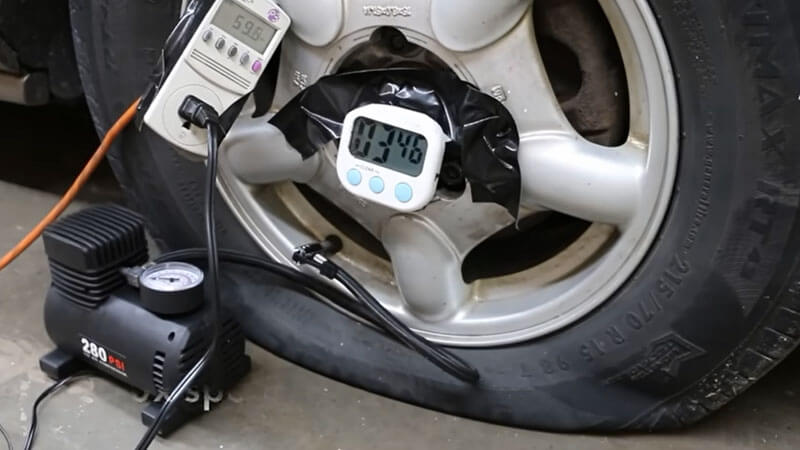Tires with low air pressure can overheat, wear unevenly, and lose efficiency, so it is important to ensure your tires always have enough air. Although most gas stations offer air inflation services, knowing how to do it on your own can save you time, cost, and hassle. You can inflate almost any tire if you have an air compressor.
When inflating tires using an air compressor, insert the tire chunk into the valve stem. Once everything is fastened down, you can fill the tires by turning on the air compressor. Generally, these are the basic rules of using air compressors to inflate tires.
However, you can read the below article for more detailed instructions on How to use Air Compressor to Inflate Tires?
Know Every Detail to Use Air Compressor to Inflate Tires
As you will work with an air compressor to inflate vehicle tires, you may be concerned about its size. However, any air compressor will do the trick when pumping up your tires. As you specify your needs, a wider variety of air compressors will become accessible. Our recommendation, however, is to use a 30-50 psi air compressor with a 3-5 hp rating. Moving on now to discussing the procedures for filling tires using an air compressor:
Understand your tire pressure
Tire pressure should always check before filling it with the air compressor. The air pressure needs of tires vary greatly, and given air pressure may be used for many different types of tires, therefore knowing the requirements of the individual tires is essential to avoid accidents.
The optimal tire pressure for a car is 32 PSI in the warmer months and 35 PSI in the wintertime. That is close to the large truck requirement of 100 pounds per square inch.
Related: Get the Size of Air Compressor with CFM/PSI to Paint Your Car Right Now!
However, the owner’s manual for your specific vehicle is the best source of information about the ideal tire pressure and whether or not the front and rear tires should have the same air pressure. A pressure gauge can also use to track tire pressure.
Pressure gauge
Using a pressure gauge is the safest and most accurate method for maintaining proper tire pressure. The proper reading from the pressure gauge will reveal whether or not the air pressure is satisfactory. Because under or over-inflation of tires can occur if too little air is added, a gauge is essential for maintaining proper tire pressure.
Remember, a tire gauge will give you an inaccurate reading if you try to measure the pressure of a tire that has been heated up, as the hot air will cause the gauge to read higher than the actual tire pressure. For this reason, it is best to use a pressure gauge and fill the tires with an air compressor while they are cold.
Get your tire ready
Step two of using an air compressor is getting the tire ready. Each tire must have a stem cap installed on its valve stem at all times. Take off the cap and put it somewhere secure; you’ll need it again. The excess air might leak out if the valve cap is removed, even temporarily. So, until the air compressor is ready to go, it is preferable to wait to inflate the tire so that no air is wasted.
Install the air compressor
Most air compressors need an electrical connection; make sure you have easy access to one and that it can handle the required voltage. It is highly suggested that you locate an outlet suitable for high voltage devices and put the 12v air compressor into that. Also, put the air compressor as close as possible to the tire you’ll be working on. However, at this time, an air hose is necessary.
Air hose
Connect one end to the air compressor and the other to the tire chuck or fast coupler. You can potentially force air into the valve stem using this way. If the nozzle has a safety switch, activate it immediately. When you turn on the switch, the compressor’s motor will begin to operate and draw air.
Detach the hose
The time required to inflate the tire will vary according to its degree of flatness. Some inflators may turn off automatically after the target pressure is reached. Digital inflators provide an alternative, as they deliver a more accurate reading.
Please be nearby while the compressor works to keep the tires from being over-inflated. Remove the air hose from the compressor once the desired pressure has been achieved. There is a hissing noise when this part is removed. This is common, so relax and reinstall the valve’s stem cap.
If you mistakenly add more air than necessary, there is nothing to worry about. Just depress the tire gauge to release some of the pressure.
4 Reasons Why an Air Compressor Fails to Inflate the Tires
The Air compressor to fill car tires is covered in detail above. However, there may still be issues, and some wonder why their air compressor is not filling the tire. Well, there are some reasons for this query. To save you from making the same mistakes, I’ve compiled a list of possible reasons why the air compressor failed to inflate the tire below.
1. If the tire is punctured
In most cases, an air compressor won’t work to fill the tire. An object from the outside could cause a puncture by penetrating the rubber and creating a small hole through which air could escape, leading to a flat tire. Likewise, if there is a hole in the tire and the air compressor is used to inflate it, the tire will never fully inflate because air will constantly escape through the hole.
Way to fix it: If you want to resolve this issue, keep a tire repair kit nearby. Using the tire repair kit, you will first be able to repair the puncture, then inflate the tire with the air compressor.
In addition, a patch, also called a gaiter, can be applied to the tire’s inner surface to fix punctures.
2. If there is a wiring problem
Occasionally, the cable or wires can become damaged at any moment, which can result in difficulty for you while trying to inflate the tires.
Way to fix it: Always double-check the cable and wire connections to the air compressor to ensure they are connected correctly before inflating the tire. An absence of power can also be caused by a short circuit or sharply bending them. Also, ensure there are no loose or broken wires in the system. This will allow you to check the air compressor’s performance before proceeding with inflation.
Related: How To Wire A 240v Air Compressor Diagram With Essential Tips
3. If the valve doesn’t work correctly
A malfunctioning valve might make it difficult to inflate tires when utilizing an air compressor.
Way to fix it: If the tire has completely flattened, you will need a beaded sweater to inflate it, as the bead may also have broken off the wheel. However, you can reseat the bead if the core is removed and substantial force is applied.
The internal valve is also easily replaceable; it just screws into place. Make sure the valve of your pump fits snugly. Check that the valve on your pump has a nice, snug fit. In addition, if the issue is with the valve itself, you will need a special tool called a Schrader valve tool to remove the Schrader valve core.
It’s conceivable that water has accumulated in the core valve, preventing it from opening but still allowing it to leak. If the pin doesn’t budge, spray some WD-40 or another penetrating oil inside the valve to see if it loosens.
4. If the nozzle is faulty
It can be challenging to fill your tires if the air compressor is not correctly attached to the nozzle. Also, incompatible nozzles on the air compressor and tires might cause air to seep, causing the tire to become underinflated.
Way to fix it: To prevent the air compressor from inflating tires correctly or letting air escape into the open, ensure the clip is tightly fastened to the nozzle. If you want to proceed, you should check to see if the nozzle is being replaced appropriately.
It’s not good enough to pull it out and plug it back in; you need to do it right each time. Also, these plugs have a wide range of forms and sizes, so selecting the correct one is important before attaching it to your nozzle.
Final Verdict
Not all air compressor failures are the result of user mistakes. Inflating tires also require several different components. You just have to ensure that you have all the necessary equipment to do this task successfully. Then, you are all set to use an air compressor to inflate tires.


